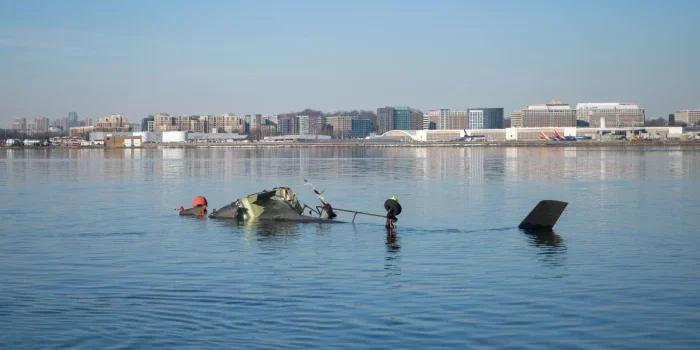The National Transportation Safety Board said the Army Black Hawk helicopter that collided with an American Airlines jet over the Potomac River last Wednesday was flying about 100 feet above the permitted flight ceiling.
The permitted flight ceiling for helicopters flying over the Potomac River in the vicinity of Reagan National Airport (DCA) is 200 feet, which is meant to keep military and law enforcement helicopters clear of commercial aircraft landing and taking off in the already tightly restricted airspace around the nation’s capital.
The Black Hawk, which was on a training mission flying out of Fort Belvoir, Va., believed to be practicing emergency evacuation routes, was flying at about 300 feet at the time of the collision
The NTSB said it relied on “multiple radar sensors and ADS-B data,” which provided the “best quality flight track data to air traffic control.”
The information fed by Potomac Terminal Radar Approach Control Facilities (TRACON) based in Warrenton, Va., showed the helicopter “was at 300 feet on the air traffic control display at the time of the collision.” They noted the flight path was rounded to the nearest 100 feet.
The latest revelation comes on the heels of an announcement from the Unified Command that all 67 victims of the collision have been recovered, including 64 from the plane and three soldiers from the helicopter. All but one of the victims have been positively identified.
“NTSB needs additional information to verify data points from the Black Hawk. In order to obtain this information, the Black Hawk needs to be recovered from the water, which is expected to take place later this week,” according to the NTSB.
NTSB has also obtained “training and flight logs for both flight crews and maintenance logs for both aircraft,” according to an update from the investigative team.
“The human performance group is building several day histories for both flight crews to include their daily activities,” said the NTSB update. “The Air Traffic Control group has completed interviews of all five staffed positions in the tower.”
The investigators will continue to “synchronize flight data recorder and cockpit voice recorder data from both aircraft, ATC communications and radar scope data” in an effort to piece together a “detailed timeframe.”
In addition, during Tuesday’s NTSB update, they revealed that Navy salvage and diving crews continued to recover wreckage from the downed plane.
So far, crews have recovered larger portions of the aircraft, including the right wing, center fuselage, part of the left-wing and left fuselage, “significant portions of the forward cabin and cockpit,” and TCAS computer and quick access recorder.
The NTSB noted that the recovered pieces will be moved to a secure location for “a wreckage layout examination.”
The latest confirmation on the Black Hawk’s altitude at the time of collision comes days after Transportation Secretary Sean Duffy announced the Federal Aviation Administration would be restricting helicopter traffic over the Potomac River stretching from Memorial Bridge to the Woodrow Wilson Bridge between the District of Columbia and Virginia in response to the collision.
Duffy said the move would ensure safety following the mid-air collision between American Airlines flight 5342 en route from Wichita, Kan., and an Army Black Hawk helicopter while the commercial jet was on approach to land at DCA.
“Today’s decision will immediately help secure the airspace near Reagan Airport, ensuring the safety of airplane and helicopter traffic,” said Duffy. The secretary said the restriction was a step in “restoring” the American people’s confidence in air travel.
“This is part of the U.S. Department of Transportation’s ongoing commitment to safeguarding our nation’s skies and upholding the highest standards of air travel safety,” he said.

